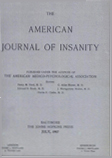INSULIN CONVULSIONS
Abstract
1. The frequency of occurrence of the insulin convulsion in the published material, if not prevented, is established as being from 2.4 per cent at the lowest to 4.1 per cent at the highest level, relative to the number of shock days.
2. Convulsions in insulin shock treatment are divided into two groups: The myoclonoid vascular collapse and the epileptoid convulsion. It is contended that the epileptoid convulsion is infrequent and depends either upon an epileptic disposition, or upon previous brain injury.
3. The myoclonoid vascular collapse is preceded by a myoclonoid pre-convulsive phase; the relationship of the occurrence of this phase to the occurrence of the convulsion proper being about 19:1. In order to prevent convulsions of the myoclonoid vascular type the injection of 1⅞ grain sodium amytal during the myoclonoid prodrome is recommended. Such an injection must be repeated in case the myoclonoid twitchings reappear. In 19.4 per cent of all sodium amytal days a second injection was required.
4. By using this method, in 42 cases with a total of 2025 insulin days and 1445 shock days, the incidence of convulsions was reduced to 3 instead of the expected 46, the percentage being 0.2 per cent instead of 2.4 per cent. A comparison of the results of groups treated with the same method, except for the prevention of convulsions, has shown that the absence of convulsions had no effect on the trend of improvement.
5. No complications arose from the use of sodium amytal. On the contrary, a smoother progress of the shock was obtained.
Access content
To read the fulltext, please use one of the options below to sign in or purchase access.- Personal login
- Institutional Login
- Sign in via OpenAthens
- Register for access
-
Please login/register if you wish to pair your device and check access availability.
Not a subscriber?
PsychiatryOnline subscription options offer access to the DSM-5 library, books, journals, CME, and patient resources. This all-in-one virtual library provides psychiatrists and mental health professionals with key resources for diagnosis, treatment, research, and professional development.
Need more help? PsychiatryOnline Customer Service may be reached by emailing [email protected] or by calling 800-368-5777 (in the U.S.) or 703-907-7322 (outside the U.S.).



